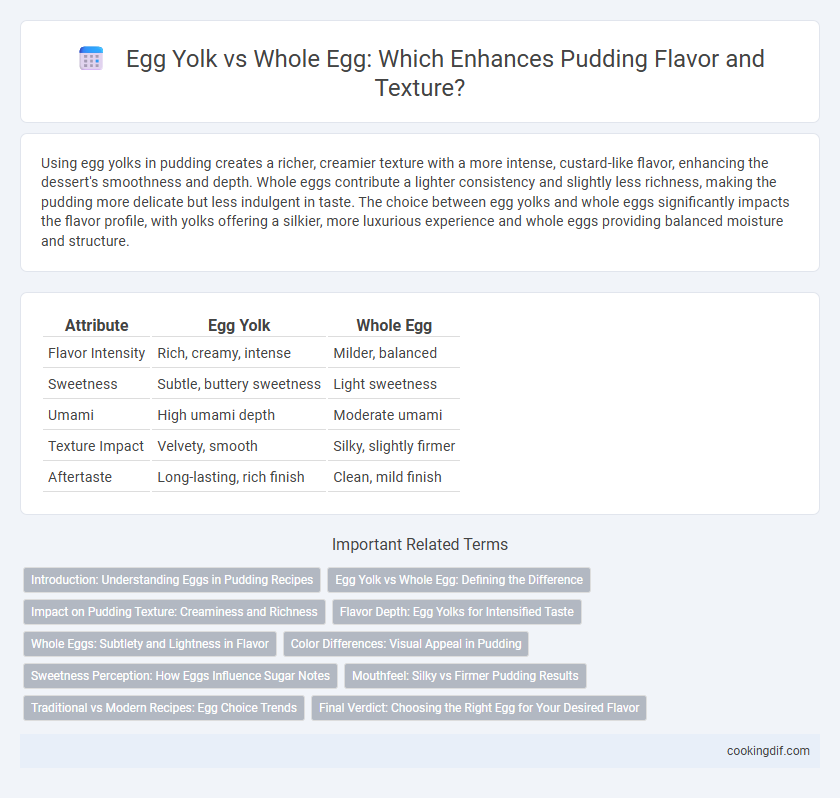Using egg yolks in pudding creates a richer, creamier texture with a more intense, custard-like flavor, enhancing the dessert's smoothness and depth. Whole eggs contribute a lighter consistency and slightly less richness, making the pudding more delicate but less indulgent in taste. The choice between egg yolks and whole eggs significantly impacts the flavor profile, with yolks offering a silkier, more luxurious experience and whole eggs providing balanced moisture and structure.
Table of Comparison
| Attribute | Egg Yolk | Whole Egg |
|---|---|---|
| Flavor Intensity | Rich, creamy, intense | Milder, balanced |
| Sweetness | Subtle, buttery sweetness | Light sweetness |
| Umami | High umami depth | Moderate umami |
| Texture Impact | Velvety, smooth | Silky, slightly firmer |
| Aftertaste | Long-lasting, rich finish | Clean, mild finish |
Introduction: Understanding Eggs in Pudding Recipes
Egg yolks contribute a rich, creamy texture and a deep, custard-like flavor to puddings, enhancing their smoothness and mouthfeel. Whole eggs provide a balanced structure by combining the richness of yolks with the light protein of whites, resulting in a firmer texture and subtle flavor complexity. Selecting egg yolk or whole egg impacts the pudding's flavor intensity and consistency, essential for tailoring recipes to desired tastes and textures.
Egg Yolk vs Whole Egg: Defining the Difference
Egg yolk imparts a rich, creamy texture and intense flavor to pudding, enhancing its smoothness and depth. Whole eggs contribute a lighter, more neutral taste while providing structure and firmness to the dessert. The choice between egg yolk and whole egg significantly impacts the pudding's mouthfeel and flavor complexity, with yolks delivering a custard-like richness and whole eggs creating a more balanced consistency.
Impact on Pudding Texture: Creaminess and Richness
Egg yolks contribute a luxurious creaminess and rich texture to pudding due to their high fat content and emulsifying properties, creating a smooth, velvety mouthfeel. Whole eggs add structure and firmness with their protein content, resulting in a slightly denser pudding while still maintaining some creaminess. Using only egg yolks enhances silkiness and depth of flavor, whereas whole eggs yield a more balanced texture combining richness with subtle firmness.
Flavor Depth: Egg Yolks for Intensified Taste
Egg yolks contribute a richer, creamier texture and a deeper, more intense flavor profile in pudding compared to whole eggs. The higher fat content and natural emulsifiers in yolks enhance the custard's smoothness and amplify its sweet, savory notes. Using only egg yolks results in a velvety pudding with concentrated dairy and egg flavors, enriching the overall taste experience.
Whole Eggs: Subtlety and Lightness in Flavor
Whole eggs contribute a subtle and light flavor to pudding, balancing richness without overwhelming sweetness. The combination of yolk and white provides a smooth texture and gentle taste that enhances the dessert's overall creaminess. Using whole eggs creates a delicate flavor profile ideal for custard-style puddings and light, airy desserts.
Color Differences: Visual Appeal in Pudding
Egg yolks provide a rich golden-yellow hue that enhances the visual appeal of pudding, delivering a vibrant and appetizing color. Whole eggs yield a paler, more muted shade due to the inclusion of egg whites, which can dilute the intensity of pigmentation. The choice between egg yolk and whole egg significantly influences the pudding's aesthetic, making yolks ideal for a more visually striking dessert.
Sweetness Perception: How Eggs Influence Sugar Notes
Egg yolks enhance pudding's richness and amplify sweetness perception by interacting with sugar molecules to create a smoother, more velvety texture and deeper caramel-like flavor notes. Whole eggs contribute a balanced flavor profile with moderate sweetness, as the egg whites dilute the yolk's intensity and add a light, airy texture that can subtly mellow sugar's impact. Choosing between egg yolk and whole egg shapes the pudding's sweetness by altering the mouthfeel and flavor complexity, influencing how sugar notes are experienced and perceived.
Mouthfeel: Silky vs Firmer Pudding Results
Egg yolks create a richer, silkier pudding with a smooth, creamy mouthfeel due to their higher fat content and emulsifying properties. Whole eggs contribute to a firmer pudding texture by adding more protein, which strengthens the custard structure and results in a slightly denser feel. Choosing egg yolks yields a velvety consistency, while whole eggs produce a thicker, more set pudding with a balanced firmness.
Traditional vs Modern Recipes: Egg Choice Trends
Traditional pudding recipes often rely on whole eggs, providing a balanced texture with moderate richness and a subtle egg flavor. Modern recipes tend to favor egg yolks for their intense creaminess and deeper, custard-like taste, enhancing the dessert's richness and smoothness. The shift towards egg yolks reflects contemporary preferences for a more luxurious mouthfeel and pronounced flavor complexity in gourmet puddings.
Final Verdict: Choosing the Right Egg for Your Desired Flavor
Egg yolks impart a rich, creamy, and custard-like flavor to pudding, enhancing its silkiness and depth. Whole eggs result in a lighter texture with a balanced egg flavor, making the pudding less dense but still smooth. For intensely rich and velvety pudding, opt for egg yolks; choose whole eggs for a subtler, more delicate flavor and structure.
Egg yolk vs Whole egg for flavor profile Infographic

 cookingdif.com
cookingdif.com